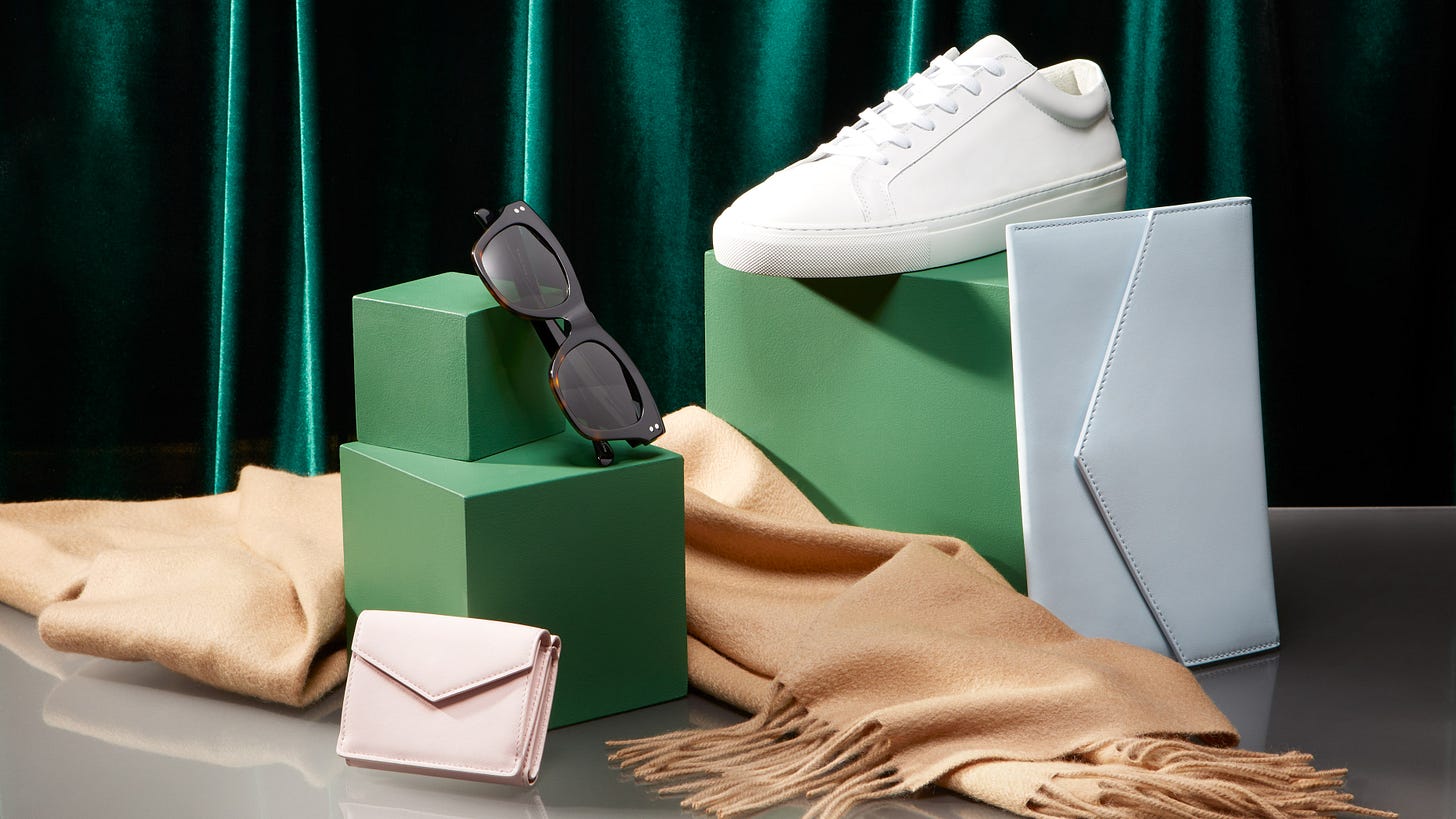(Ep 48) ITALIC -> The annual membership for affordable luxury 🏭
Jeremy Cai | Founder & CEO
Hey friends,
Back again with another edition of The Founder recap - this is Episode 48. If you’re new here, my goal is to give you a quick synopsis of what got me thinking from this week’s episode of The Founder Podcast in 5 minutes or less.
No idea what The Founder is? Read this.
Mission control:
Learn -> Founder favorite resources
Free money -> Discount codes
And who am I?
I’m Kallaway - a future founder trying to get some answers before I jump in the ball pit myself.
Let’s get it.
This Week’s Episode (Ep 48) 🏭
Guest -> Jeremy Cai, Founder & CEO of Italic
Mission -> Italic is on a mission to disrupt the traditional retail value chain and give its members access to high-end products at affordable prices.
Discount -> Use link [italic.com/founder] for 30% off your first year’s membership
Episode available on -> Apple Podcasts | Spotify | YouTube | Website
In this episode we talk with Jeremy about…
👶 The origin story of Italic
🏆 Dropping out of the #1 entrepreneurship program in the country
🤯 How Italic is disrupting traditional retail and enabling affordable luxury
⚙️ The evolution of Italic’s membership model and product flywheel
💰 Jeremy’s angel investing approach
🔨 Brainstorm of the week -> Building verticalized software for niche businesses, supply chain solutions (e.g., cold storage, international logistics), community group buying business models
Summary 🔍
What is Italic and how did Jeremy get started?
There’s no way around it…Jeremy Cai has an impressive resume.
After dropping out of Babson College’s #1 ranked undergraduate entrepreneurship program, Jeremy quickly migrated to Silicon Valley. He initially interned at Shyp, and ultimately landed the Thiel Fellowship, a two year program for aspiring young entrepreneurs that pays them $100K to build products instead of sit in the classroom.
During his time as a Thiel Fellow, Jeremy began building his first company, Fountain, an all-in-one hiring platform designed for companies that need access to hourly workers and gig freelancers.
Jeremy and his Co-Founder Keith went through YCombinator as a part of the S15 cohort.
After leaving Fountain in 2018, Jeremy began building what would become Italic.
Italic is positioned to disrupt the traditional retail value chain by giving consumers access to high-end products at cost. That means you only pay what it costs the manufacturer to make and deliver it to you – no markups for branding or retail middlemen.
Imagine getting access to products from Burberry, Prada, Alexander Wang, Tumi and All Clad for 80% off traditional retail price!
[Italic has officially entered the chat]
How do they do it?
Italic built relationships with the same manufacturers that make the raw goods for your favorite luxury brands. Instead of pushing manufacturers to drive prices down, Italic realigns incentives by paying manufacturers more and passing the traditional brand mark-up margin onto customers as savings.
Instead of making a large profit on each item, Italic charges an annual membership fee of $120 for members to access all of their products. It’s the members only shopping club you’ve always dreamed of.
And because Jeremy is a friend, he’s offering 30% off your first year of the membership to join the club. Visit italic.com/founder to take advantage of the offer!
I’m currently an Italic member as recently bought the Zest Stainless Steel Tri-Ply 10 Piece Cookware Set for $140. All-Clad sells the same set for $800 🤯
🚀 Here’s why I’m a fan and excited about Italic 🚀
Italic is one of my favorite emerging companies for several reasons:
Disruption of a legacy model - Italic is taking on consumer luxury retail, a model that hasn’t truly been disrupted in a while. The initial DTC wave radically changed the value chain by cutting out the need for traditional retailers, but the majority of the value was still being captured by the brand. Italic’s take on retail is radically different - share more profits with the manufacturer and the end consumer and eliminate the massive brand margin
Supporting underrepresented parties [manufacturers and consumers] - In the traditional retail model, manufacturer margins are consistently squeezed. The more volume a brand does, the harder to negotiates unit costs down with manufacturers. It’s a race to the bottom. Italic is flipping that on its head and offering 2-3x margins for manufacturers while also promising a more direct path to consumers in the future. On the consumer side, prices for luxury goods have gotten astronomical. A Prada shirt that costs $15 to make might cost $220 for the end consumer. This pricing model prevents middle and even upper middle class from accessing luxury products. Italic offers 50-80% discounts off luxury branded products which expands the customer base that can purchase them
Bold future vision [powering direct to consumer for manufacturers] - While still early in the journey, Italic’s blue sky vision is to become the platform layer that helps manufacturers connect directly with consumers. They want to build the tools and software that help power that relationship. Think of some form of Shopify but instead of DTC brands, it will be manufacturers running the supply side directly
Modern, minimalist brand with commitment to high product quality - If you’ve spent 30 seconds on the Italic site, it becomes immediately clear that they are obsessed with product quality and design. I love companies that make a commitment to quality at all costs
Jeremy’s Startup Manifesto 📜
What’s a Startup Manifesto?
During each episode, I ask all of my founder guests this question:
If you had to write a Startup Manifesto with 5 of the most important key lessons or pitfalls to avoid when starting out, what would they be?
Here’s what Jeremy had to say:
Follow less heuristics and ignore most advice. What works for other companies, more often than not, might not work for yours
It really helps younger/first-time founders to find peers that are a couple years ahead of you that are willing to go to bat for you and be your champion. This will help save you a ton of time and headache overtime
A lot of the fluffy BS stuff that a younger founder might think is baloney (culture, values, etc.) actually matters. You can’t retroactively fix it, so be very intentional and set culture from an early point in the company’s lifecycle. Think of culture as operating principles. I put this off in both of our companies and regret it both times
You have to very deliberate in what you’re trying to achieve with the business. For my first company, we were building a startup just to build a startup and that is probably the worst reason to start something. If you’re doing this for money, own that
You don’t have to work with people you don’t want to. If I were to give myself advice early on, I would say hey, you have the choice to hire people or take their money. Sometimes we chase logos, resumes and experience but we ignore the core people we are engaging with. You want to surround yourself with people you’re excited to be around
Here’s a thread I wrote breaking down some of the exciting elements of Italic👇
What Got Me Thinking From the Episode 🤔
After reflecting on my conversation with Jeremy, here’s something that really got my wheels spinning:
Setting Bold Visions 👍🏽
This was one of my favorite conversations on the podcast to date because Jeremy painted a picture of a super-bold vision -> empowering manufacturers to go direct to consumers and cutting out brands altogether.
That’s a wild reality to think about.
Previously, most manufacturers have largely been thought of as a commodity layer in the retail value chain. An unsophisticated analyst would assume there are typically dozens of manufacturers that each brand has to choose from. In this world, manufacturers are solely meant to provide raw goods and are in a race to the bottom on price.
In a world powered by Italic, that is no longer the case — manufacturers will become the supply engine for consumers.
To me, Italic is a story of realigning incentives.
Think about the major stakeholders in the retail value chain today
Manufacturers - often overseas, making the raw product
Shipping/logistics - transporting the raw product to final destination
Retailer (optional) - physical/digital storefront selling products from multiple brands
Brand - product designer/tastemaker/logo
Customer
In the legacy model, a $100 shirt might send $16 to the manufacturer, $4 to logistics, $20 to retailer and $60 to the brand.
In this model, the manufacturer is squeezed and doesn’t have an incentive to innovate or drive process improvement.
The Italic team thought, “What if we cut out the brands just like they cut out the retailers when they went DTC?”
Today, manufacturers don’t have the infrastructure (e.g., front-end site, ordering/billing systems, international payments, credibility, etc.) to go direct to customers. The only examples where this is happening today are places like Alibaba, but that is still a gamble on quality for a US consumer and takes weeks for goods to be delivered.
What if Italic built that infrastructure to help facilitate the relationship of manufacturer -> customer directly?
The manufacturer could capture more of the margin, Italic could take a fee in the middle (if they wanted) and the customer could purchase the same goods at a fraction of the current price.
That’s bold and would completely disrupt retail as we know it.
I highlight this line of thinking because bold ideas are where the true innovation comes from.
If you’re an aspiring entrepreneur, try to take what’s being done and go from V1 -> V5. V1 -> V1.1 is less interesting and often not worth a 10 year sacrifice to achieve.
Wrapping it Up 📕
I hope you found this interesting and inspiring! If so and you want to help support our journey to bring The Founder to millions of people across the world, here’s a couple things that would be really valuable to me and the show:
If you enjoyed this post, share it with one friend that you think is on the same wavelength.
If you haven’t already, subscribe to this newsletter so you can get them delivered to your inbox each week!
Listen to the full podcast episode with Jeremy on Apple or Spotify. If you don’t have an hour to listen to the full episode, pick a couple of topics you’re interested in and skim through (topic time codes in the show notes).
Watch the full episode and our top clips on YouTube.
If you’re feeling super giving:
Find our show on Apple Podcasts (https://apple.co/2VCosu6) and (1) subscribe, (2) give a 5-star rating and (3) leave a couple sentence positive review. This doesn’t seem like it would move the needle but it really is a massive help!
Till next time ✌️
Kallaway
Want more? Check out other founders we’ve featured on the show!
— 📩 46. Morning Brew | Alex Lieberman
— 📖 36. Toucan | Taylor Nieman
— 🛋️ 34. Burrow | Stephen Kuhl
— 🛌 30. Eight Sleep | Matteo Franceschetti
— 🌵 25. The Sill | Eliza Blank
— 🥦 22. Levels | Josh Clemente
— 💍 11. The Clear Cut | Olivia Landau and Kyle Simon
— 🥘 7. Kettle & Fire | Justin Mares
— 🥾 2. Thursday Boots | Connor Wilson
See any mistakes or have feedback? Let me know (kallaway@thefounderpod.com)






